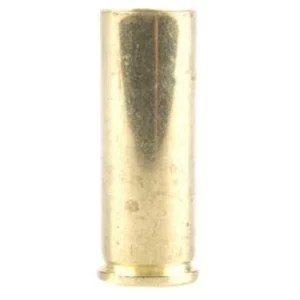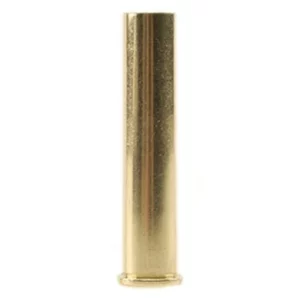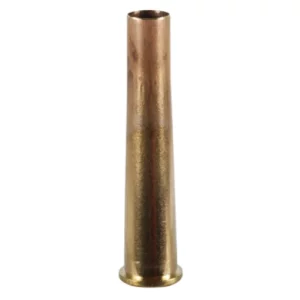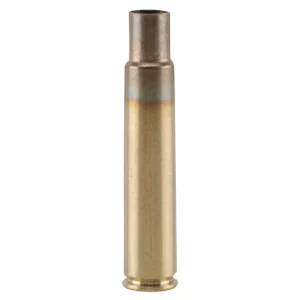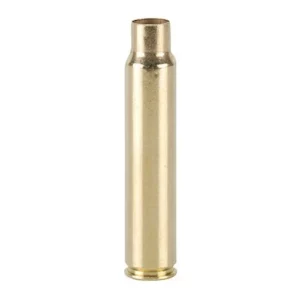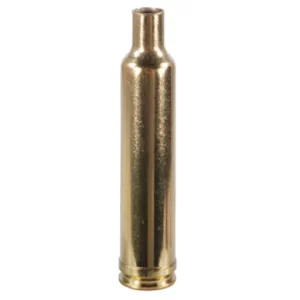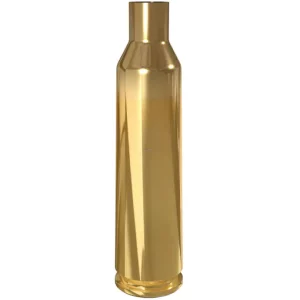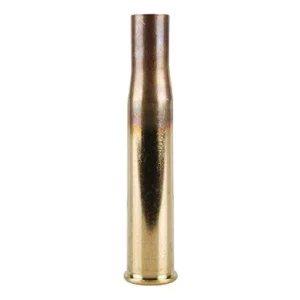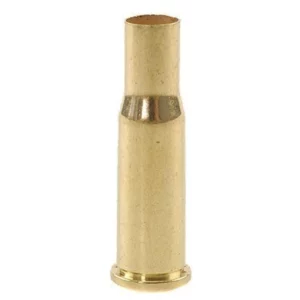Reloading Brass
-
Starline Brass 41 Long Colt
Starline Brass prides itself on producing the highest quality brass case available. Their brass is comprised of 70% copper and 30% zinc and is vertically drawn during the manufacturing process which results in more uniform wall thickness. Cases are annealed between each draw to ensure consistent metallurgy in all lots. Each brass case is hand inspected to guarantee the highest quality possible.
Starline Brass is located in Sedalia, MO and has been in business for over 30 years. Trust Starline for your next reloads, you won’t be disappointed. New, unprimed brass. This is not loaded ammunition. Bulk brass should be full-length sized, trimmed and chamfered before loading.
Brass Preparation: With bulk rifle brass you may sometimes notice a few case mouths are “out of round” or slightly dented below the shoulder. These imperfections occur in the final tumbling wash operation after the case mouth has been annealed. Brass manufacturers are aware of the case cosmetics and have worked to mitigate it, but due to equipment design, denting may still occur. Minor dents are normally removed in the first firing and will not affect case life or performance. On non-plated brass, you may also notice all the anneal stain might not be polished off, which may give the case neck a pinkish color. With some smaller caliber cases you may notice the case mouths to be slightly belled.
With all new rifle brass, you should first straighten out the case and case mouth, then chamfer and debur the case mouth inside and out. To straighten the case mouth, run the case part way into the sizer die and let the expander ball straighten the brass. To prevent the case neck from stretching, be sure to lubricate the case neck inside the case mouth.
If you are using Nickel plated brass, special care must be taken to lubricate the cases prior to sizing them. Nickel plating is harder than brass and the cases require more effort in sizing. In the event a case becomes stuck, purchase a stuck case remover; don’t use pliers, screwdrivers or other common household tools which could damage your sizing die.
CAD $101.00Starline Brass 41 Long Colt
CAD $101.00 -
Winchester Brass 375 Winchester Bag of 50
Winchester Reloading Brass is manufactured to extremely tight tolerances to ensure smooth feeding and positive chambering. Consistent case-to-case weight and capacity delivers outstanding accuracy. Winchester’s high quality, durable brass can be reloaded several times. New, unprimed brass. This is not loaded ammunition.
Brass Preparation: With bulk rifle brass you may sometimes notice a few case mouths are “out of round” or slightly dented below the shoulder. These imperfections occur in the final tumbling wash operation after the case mouth has been annealed. Brass manufacturers are aware of the case cosmetics and have worked to mitigate it, but due to equipment design, denting may still occur. Minor dents are normally removed in the first firing and will not affect case life or performance. On non-plated brass, you may also notice all the anneal stain might not be polished off, which may give the case neck a pinkish color. With some smaller caliber cases you may notice the case mouths to be slightly belled.
With all new rifle brass, you should first straighten out the case and case mouth, then chamfer and debur the case mouth inside and out. To straighten the case mouth, run the case part way into the sizer die and let the expander ball straighten the brass. To prevent the case neck from stretching, be sure to lubricate the case neck inside the case mouth.
If you are using Nickel plated brass, special care must be taken to lubricate the cases prior to sizing them. Nickel plating is harder than brass and the cases require more effort in sizing. In the event a case becomes stuck, purchase a stuck case remover; don’t use pliers, screwdrivers or other common household tools which could damage your sizing die.
CAD $59.40Winchester Brass 375 Winchester Bag of 50
CAD $59.40 -
Winchester Brass 25-35 WCF Bag of 50
Winchester makes the highest quality brass available, and each and every piece is made to meet and exceed the most demanding quality control and performance standards in the industry. New, unprimed brass. This is not loaded ammunition.
Preparation:
- Due to the manufacturing process and/or shipping, case mouths may not be perfectly round. To ensure a round case mouth, cases must be sized (or have the expander ball of the sizing die run through case neck) and deburred/Chamfered prior to loading.
Note:
- A light “staining” may be found on the case neck of new brass. This is due to annealing. Annealing is a process, performed by the manufacturer, which involves rapid heating to a specified temperature followed by rapid cooling. This process imparts cases with the proper hardness to securely hold a bullet as well as gives flexibility to expand and contract upon firing and repeated forming. The “staining” is a residue from this process. This stain may be removed by tumbling before loading. Brass should be full-length sized, trimmed and chamfered before loading.
CAD $47.25Winchester Brass 25-35 WCF Bag of 50
CAD $47.25 - Due to the manufacturing process and/or shipping, case mouths may not be perfectly round. To ensure a round case mouth, cases must be sized (or have the expander ball of the sizing die run through case neck) and deburred/Chamfered prior to loading.
-
Quality Cartridge Brass 32-40 Winchester Box of 20
Quality Cartridge started in 1990 manufacturing custom, obsolete and wildcat cartridge cases. Quality Cartridge uses the highest quality materials and equipment to produce the best brass available. Along with the high quality of their products Quality Cartridge also properly head stamps over 450 different calibers from popular wildcats to obsolete cartridges. It is easy to see why Quality Cartridge has become the go-to source for obscure cartridge needs.
Because of variations in case size for some specialty cartridges, it is best to check the brass against a fired case from a particular firearm to ensure suitability. Whenever possible, brass has been formed to published standards for the cartridge. This is not loaded ammunition.
Brass Preparation: With bulk rifle brass you may sometimes notice a few case mouths are “out of round” or slightly dented below the shoulder. These imperfections occur in the final tumbling wash operation after the case mouth has been annealed. Brass manufacturers are aware of the case cosmetics and have worked to mitigate it, but due to equipment design, denting may still occur. Minor dents are normally removed in the first firing and will not affect case life or performance. On non-plated brass, you may also notice all the anneal stain might not be polished off, which may give the case neck a pinkish color. With some smaller caliber cases you may notice the case mouths to be slightly belled.
With all new rifle brass, you should first straighten out the case and case mouth, then chamfer and debur the case mouth inside and out. To straighten the case mouth, run the case part way into the sizer die and let the expander ball straighten the brass. To prevent the case neck from stretching, be sure to lubricate the case neck inside the case mouth.
CAD $46.00 -
Hornady Brass 416 Rigby Brass Box of 20
Hornady produces brass with the same precision, attention to detail and focus on perfection that has made them a world leader in bullets. They measure their brass for consistent wall concentricity, tests pressure calibration to ensure uniform case expansion and hand-inspects each piece.
This dedication to quality ensures proper seating of the bullet both in the case and in the chamber and consistent charges and pressures. The result is optimal velocity and repeatable accuracy from your cartridges. New, unprimed brass. This is not loaded ammunition.
Brass Preparation: With bulk rifle brass you may sometimes notice a few case mouths are “out of round” or slightly dented below the shoulder. These imperfections occur in the final tumbling wash operation after the case mouth has been annealed. Brass manufacturers are aware of the case cosmetics and have worked to mitigate it, but due to equipment design, denting may still occur. Minor dents are normally removed in the first firing and will not affect case life or performance. On non-plated brass, you may also notice all the anneal stain might not be polished off, which may give the case neck a pinkish color. With some smaller caliber cases you may notice the case mouths to be slightly belled.
With all new rifle brass, you should first straighten out the case and case mouth, then chamfer and debur the case mouth inside and out. To straighten the case mouth, run the case part way into the sizer die and let the expander ball straighten the brass. To prevent the case neck from stretching, be sure to lubricate the case neck inside the case mouth.
CAD $69.00Hornady Brass 416 Rigby Brass Box of 20
CAD $69.00 -
Hornady Brass 375 Ruger Box of 50
Hornady produces brass with the same precision, attention to detail and focus on perfection that has made them a world leader in bullets. They measure their brass for consistent wall concentricity, tests pressure calibration to ensure uniform case expansion and hand-inspects each piece.
This dedication to quality ensures proper seating of the bullet both in the case and in the chamber and consistent charges and pressures. The result is optimal velocity and repeatable accuracy from your cartridges. New, unprimed brass. This is not loaded ammunition.
Brass Preparation: With bulk rifle brass you may sometimes notice a few case mouths are “out of round” or slightly dented below the shoulder. These imperfections occur in the final tumbling wash operation after the case mouth has been annealed. Brass manufacturers are aware of the case cosmetics and have worked to mitigate it, but due to equipment design, denting may still occur. Minor dents are normally removed in the first firing and will not affect case life or performance. On non-plated brass, you may also notice all the anneal stain might not be polished off, which may give the case neck a pinkish color. With some smaller caliber cases you may notice the case mouths to be slightly belled.
With all new rifle brass, you should first straighten out the case and case mouth, then chamfer and debur the case mouth inside and out. To straighten the case mouth, run the case part way into the sizer die and let the expander ball straighten the brass. To prevent the case neck from stretching, be sure to lubricate the case neck inside the case mouth.
CAD $82.00Hornady Brass 375 Ruger Box of 50
CAD $82.00 -
Hornady Brass 257 Weatherby Magnum Box of 50
Hornady produces brass with the same precision, attention to detail and focus on perfection that has made them a world leader in bullets. They measure their brass for consistent wall concentricity, tests pressure calibration to ensure uniform case expansion and hand-inspects each piece.
This dedication to quality ensures proper seating of the bullet both in the case and in the chamber and consistent charges and pressures. The result is optimal velocity and repeatable accuracy from your cartridges. New, unprimed brass. This is not loaded ammunition.
Brass Preparation: With bulk rifle brass you may sometimes notice a few case mouths are “out of round” or slightly dented below the shoulder. These imperfections occur in the final tumbling wash operation after the case mouth has been annealed. Brass manufacturers are aware of the case cosmetics and have worked to mitigate it, but due to equipment design, denting may still occur. Minor dents are normally removed in the first firing and will not affect case life or performance. On non-plated brass, you may also notice all the anneal stain might not be polished off, which may give the case neck a pinkish color. With some smaller caliber cases you may notice the case mouths to be slightly belled.
With all new rifle brass, you should first straighten out the case and case mouth, then chamfer and debur the case mouth inside and out. To straighten the case mouth, run the case part way into the sizer die and let the expander ball straighten the brass. To prevent the case neck from stretching, be sure to lubricate the case neck inside the case mouth.
CAD $88.00Hornady Brass 257 Weatherby Magnum Box of 50
CAD $88.00 -
Lapua Brass 22-250 Remington
Lapua World-class brass begins with high-quality raw materials and superior smelting and metallurgical competence. Throughout the production process, the focus on quality control is consistent with Lapua’s exacting standards. Particular attention is paid to hardness, solidity and grain structure. All Lapua brass is tested to 30% overpressure according to Commission Internationale Permanente, the agency that oversees ammunition and component producers in Western Europe. This is not loaded ammunition.
Brass Preparation: With bulk rifle brass you may sometimes notice a few case mouths are “out of round” or slightly dented below the shoulder. These imperfections occur in the final tumbling wash operation after the case mouth has been annealed. Brass manufacturers are aware of the case cosmetics and have worked to mitigate it, but due to equipment design, denting may still occur. Minor dents are normally removed in the first firing and will not affect case life or performance. On non-plated brass, you may also notice all the anneal stain might not be polished off, which may give the case neck a pinkish color. With some smaller caliber cases you may notice the case mouths to be slightly belled.
With all new rifle brass, you should first straighten out the case and case mouth, then chamfer and debur the case mouth inside and out. To straighten the case mouth, run the case part way into the sizer die and let the expander ball straighten the brass. To prevent the case neck from stretching, be sure to lubricate the case neck inside the case mouth.
CAD $139.00Lapua Brass 22-250 Remington
CAD $139.00 -
Winchester Brass 32 Winchester Special Bag of 50
Winchester Reloading Brass is manufactured to extremely tight tolerances to ensure smooth feeding and positive chambering. Consistent case-to-case weight and capacity delivers outstanding accuracy. Winchester’s high quality, durable brass can be reloaded several times. New, unprimed brass. This is not loaded ammunition.
Brass Preparation: With bulk rifle brass you may sometimes notice a few case mouths are “out of round” or slightly dented below the shoulder. These imperfections occur in the final tumbling wash operation after the case mouth has been annealed. Brass manufacturers are aware of the case cosmetics and have worked to mitigate it, but due to equipment design, denting may still occur. Minor dents are normally removed in the first firing and will not affect case life or performance. On non-plated brass, you may also notice all the anneal stain might not be polished off, which may give the case neck a pinkish color. With some smaller caliber cases you may notice the case mouths to be slightly belled.
With all new rifle brass, you should first straighten out the case and case mouth, then chamfer and debur the case mouth inside and out. To straighten the case mouth, run the case part way into the sizer die and let the expander ball straighten the brass. To prevent the case neck from stretching, be sure to lubricate the case neck inside the case mouth.
If you are using Nickel plated brass, special care must be taken to lubricate the cases prior to sizing them. Nickel plating is harder than brass and the cases require more effort in sizing. In the event a case becomes stuck, purchase a stuck case remover; don’t use pliers, screwdrivers or other common household tools which could damage your sizing die.
CAD $44.55 -
Hornady Brass 450-400 Nitro Express 3″ Box of 20
Hornady produces brass with the same precision, attention to detail and focus on perfection that has made them a world leader in bullets. They measure their brass for consistent wall concentricity, tests pressure calibration to ensure uniform case expansion and hand-inspects each piece.
This dedication to quality ensures proper seating of the bullet both in the case and in the chamber and consistent charges and pressures. The result is optimal velocity and repeatable accuracy from your cartridges. New, unprimed brass. This is not loaded ammunition.
Brass Preparation: With bulk rifle brass you may sometimes notice a few case mouths are “out of round” or slightly dented below the shoulder. These imperfections occur in the final tumbling wash operation after the case mouth has been annealed. Brass manufacturers are aware of the case cosmetics and have worked to mitigate it, but due to equipment design, denting may still occur. Minor dents are normally removed in the first firing and will not affect case life or performance. On non-plated brass, you may also notice all the anneal stain might not be polished off, which may give the case neck a pinkish color. With some smaller caliber cases you may notice the case mouths to be slightly belled.
With all new rifle brass, you should first straighten out the case and case mouth, then chamfer and debur the case mouth inside and out. To straighten the case mouth, run the case part way into the sizer die and let the expander ball straighten the brass. To prevent the case neck from stretching, be sure to lubricate the case neck inside the case mouth.
CAD $69.00 -
Federal Premium Gold Medal Brass 300 Winchester Short Magnum (WSM) Bag of 50
Federal is known for loading some of the best factory ammunition available and this brass is no different. This brass is manufactured to the same high standards and consistency that have made Federal Premium Ammunition one of the favorites of shooters everywhere. This is not loaded ammunition.
Brass Preparation: With bulk rifle brass you may sometimes notice a few case mouths are “out of round” or slightly dented below the shoulder. These imperfections occur in the final tumbling wash operation after the case mouth has been annealed. Brass manufacturers are aware of the case cosmetics and have worked to mitigate it, but due to equipment design, denting may still occur. Minor dents are normally removed in the first firing and will not affect case life or performance. On non-plated brass, you may also notice all the anneal stain might not be polished off, which may give the case neck a pinkish color. With some smaller caliber cases you may notice the case mouths to be slightly belled.
With all new rifle brass, you should first straighten out the case and case mouth, then chamfer and debur the case mouth inside and out. To straighten the case mouth, run the case part way into the sizer die and let the expander ball straighten the brass. To prevent the case neck from stretching, be sure to lubricate the case neck inside the case mouth.
CAD $74.25 -
Winchester Brass 25-20 WCF Bag of 50
Winchester Reloading Brass is manufactured to extremely tight tolerances to ensure smooth feeding and positive chambering. Consistent case-to-case weight and capacity delivers outstanding accuracy. Winchester’s high quality, durable brass can be reloaded several times. New, unprimed brass. This is not loaded ammunition.
Brass Preparation: With bulk rifle brass you may sometimes notice a few case mouths are “out of round” or slightly dented below the shoulder. These imperfections occur in the final tumbling wash operation after the case mouth has been annealed. Brass manufacturers are aware of the case cosmetics and have worked to mitigate it, but due to equipment design, denting may still occur. Minor dents are normally removed in the first firing and will not affect case life or performance. On non-plated brass, you may also notice all the anneal stain might not be polished off, which may give the case neck a pinkish color. With some smaller caliber cases you may notice the case mouths to be slightly belled.
With all new rifle brass, you should first straighten out the case and case mouth, then chamfer and debur the case mouth inside and out. To straighten the case mouth, run the case part way into the sizer die and let the expander ball straighten the brass. To prevent the case neck from stretching, be sure to lubricate the case neck inside the case mouth.
If you are using Nickel plated brass, special care must be taken to lubricate the cases prior to sizing them. Nickel plating is harder than brass and the cases require more effort in sizing. In the event a case becomes stuck, purchase a stuck case remover; don’t use pliers, screwdrivers or other common household tools which could damage your sizing die.
CAD $28.35Winchester Brass 25-20 WCF Bag of 50
CAD $28.35

